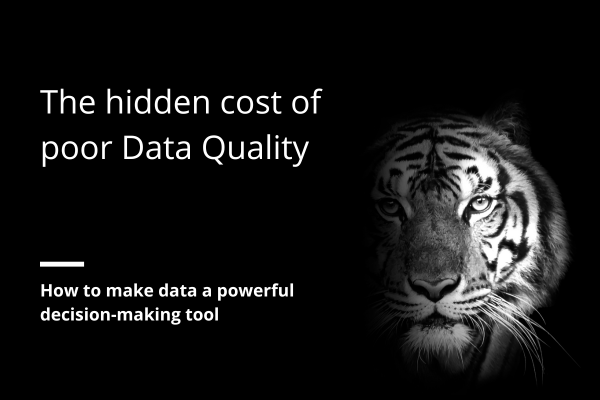Imagine you’re the CEO of a Fortune 500 company. You’re about to make a decision that will shape the future of your business for years to come. You’ve dig through the reports, analyzed market trends, and consulted with your top executives. You’re confident in your choice. But what if I told you that your decision was based on a single misplaced decimal point?
This isn’t a hypothetical scenario. In 1999, NASA lost a $125 million Mars orbiter because one engineering team used metric units while another used English units for a key spacecraft operation. A simple data discrepancy led to one of the most expensive typing errors in history.
While not all data quality issues result in spacecraft-destroying mistakes, the principle remains the same: the quality of your data directly impacts the quality of your decisions.
The critical role of data quality in business
Today data acts as the backbone of companies, just like electricity powers the machines around us. It fuels innovations, informs strategic decisions, and drives profitability when used correctly. However, for data to be a true asset, its quality must be non-negotiable.
According to Forrester study, companies that prioritize data quality are 58% more likely to exceed their revenue goals compared to those that don’t. The reason is simple: high-quality data leads to better insights, which drive more effective strategies and operations.
However, achieving high data quality is a significant challenge for most organizations. Harvard Business Review study reveals that only 3% of companies’ data meet basic quality standards.
But what exactly do we mean by « data quality »? It is defined by data that is:
- Accurate: Correctly representing the real-world entity or event
- Consistent: Free from contradictions across different systems or reports
- Valid: properly structured (format, type, range) and contains the values of its definition
- Complete: Containing all necessary information (including metadata)
- Timely: Up-to-date and available when needed
- Unique: Avoiding duplication of data records
To these, we should add one more dimension:
- Compliant: Following data standards and regulations
When data meets these criteria, it becomes a powerful tool for decision-making. However, when it falls short, the consequences can be very expensive. The HBR article points out that poor data quality is not just a technical issue – it’s a business problem that affects the entire organization.
Moreover, HBR emphasizes that improving data quality is not a one-time project but an ongoing process. It requires a combination of technology, processes, and perhaps most importantly, a data-aware culture where every employee understands their role in maintaining data quality.
The hidden costs of poor data quality
While the Mars Climate Orbiter incident is a dramatic example of the consequences of poor data quality, the everyday impact on businesses can be just as significant, but less visible.
Gartner research suggests that poor data quality costs organizations an average of $12.9 million annually. This figure isn’t just about direct financial losses. It combines decreased productivity, missed opportunities, and damaged reputation.
But the costs go beyond immediate financial impact. Bad data erodes trust within organizations. When employees can’t rely on the information they’re given, decision-making slows, innovation stops, and morale suffers.
Real-world consequences: case studies
Let’s dive into some real-world examples that illustrate the consequences of poor data quality:
- The $6 billion Excel error: In 2012, JPMorgan Chase reported a trading loss of $6 billion, partly due to errors in their value-at-risk (VaR) model. A seemingly small error in their Excel spreadsheet led to major underestimation of the potential for loss in their synthetic credit portfolio.
- The misplaced patients: In 2017, the UK’s National Health Service faced a crisis when it was revealed that 709,000 patient documents had been misplaced. This data quality issue put patients lives at risk and cost millions to fix.
- The tax office blunder: In 2014, Amsterdam tax office gave out €188 million to around 10,000 households in yearly government rent subsidies instead of €2 million. The reason? Amsterdam’s government software calculated payments in cents instead of euros. On top of that, the city spent €300,000 more on trying to understand and resolve this issue.
GDPR and the legal risks of bad data
The introduction of the General Data Protection Regulation (GDPR) in 2018 added a new dimension to the data quality challenge. Under GDPR, organizations are not only required to protect personal data but also to ensure its accuracy and relevance.
Article 5 of GDPR states that personal data must be « accurate and, where necessary, kept up to date. » This means that maintaining high data quality is no longer just a business imperative – it’s a legal requirement.
The consequences of non-compliance can be severe. GDPR allows for fines of up to €20 million or 4% of global annual turnover, whichever is higher. In 2019, British Airways was fined £183 million for a data breach that affected 500,000 customers. While this was primarily a security issue, it highlights the potential scale of GDPR penalties.
But the risks go beyond fines. Poor data quality can lead to:
- Inability to fulfill Data Subject Rights (DSRs): If you can’t find or verify an individual’s data, you can’t comply with requests for access, rectification or erasure.
- Breach of data minimization principle: Keeping unnecessary or outdated data violates GDPR’s data minimization requirement.
- Reputational damage: Data quality issues that lead to GDPR violations can drastically damage public trust in an organization.
Best practices for ensuring data quality
Given the high stakes, how can companies ensure they maintain high data quality? Here are some best practices:
- Implement a data governance framework: Establish clear policies and procedures for data management. Assign Data Stewards responsible for maintaining data quality in their domains.
- Use data quality tools: Use systems that can automatically validate data against predefined rules. Best tools offer also data quality score for each record.
- Foster a data-aware culture Train employees at all levels about the importance of data quality. Encourage a mindset where everyone sees themselves as stewards of organizational data.
- Regular audits: Conduct periodic reviews of your data assets to identify and rectify quality issues.
- Invest in the right technology to ensure consistency across all data sources and systems.
Conclusion: The future of business decisions
As we move further into the age of AI and machine learning, the importance of data quality will only grow. These advanced technologies are only as good as the data they’re trained on. Poor quality data doesn’t just lead to bad decisions – it can lead to biased algorithms and flawed AI models that iterate and make errors at scale.
The future belongs to organizations that recognize data quality as a strategic asset. By investing in data quality, businesses aren’t just avoiding costly mistakes – they’re laying the foundation for innovation, growth, and competitive advantage in the economy of tomorrow.
In the words of William Edwards Deming, the father of quality management: « In God we trust. All others must bring data. » Today we might add: « And that data better be good. »









